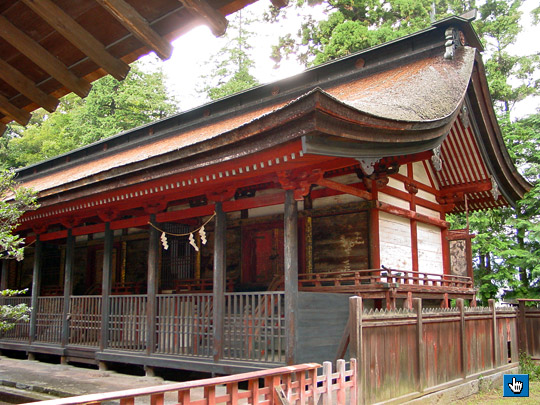| Also
nagare hafu-zukuri 流破風造. A widely used style of main sanctuary *honden
本殿, architecture found at Shinto shrines. Shrines that employ this style are not
confined to any particular region of Japan. The most distinguishing characteristic
of nagare-zukuri is its gable roof which is unique in its asymmetrical
balance, having a long extended front slope with a flowing curve covering both
the step-canopy *kouhai
向拝, and pent roof *hisashi
廂, over the veranda and steps. The front roof slope is called mae-nagare
前流 and the rear roof slope *ushiro-nagare
後流 The name nagare-zukuri or flowing style is thought to have derived
from the shape of the front part of the gabled roof. The entrance is on the side
parallel to the ridge. Honden range from one bay wide ikkensha
一間社 (see *ikkensha-zukuri
一間社造), to 11 bays wide juuichikensha 十一間社, but are never 6 or 8 bays wide.
The most common are one-bay or three-bays wide. The building's support pillars
are round. The pillars that sustain the extended roof over the step-canopy and
the outer edges of the verandas are square. All pillars are set on bases which
are either circular or square. The floor level of the building's core *moya
母屋, is raised considerably above ground level. The entrance has a short flight
of steep, square-cut, thick plank steps with low railings on each side. The railings
usually continue along the edge of the narrow verandas skirting the sides and
rear of the building. Unless another structure is attached to the side of the
honden, verandas often have railings that terminate at the back ends of
the verandas on each side. Panels *wakishouji
脇障子, extend the width the veranda at right angles to the rear corner pillars.
Another style of railing is either crossed and curves upward at the outer corners
hanekouran 刎高欄 or is inserted into posts crowned with an onion-shaped knob
*giboshi 擬宝珠. Occasionally,
there is no railing around the veranda as at Araki Jinja Honden 荒城神社本殿 (1390)
in Gifu prefecture. Many shrines in this style have a platform-like area on which
the pillars of the step-canopy rest. See *hamayuka
浜床. There is a great variety of visible structural materials: different roofing
materials, decorative sliding lattice doors, metal fittings, horizontal plank
or plastered walls, and exposed timber either left untouched to weather naturally,
painted or lacquered. See *sanja-zukuri
三社造, *ryounagare-zukuri
両流造. Examples: Ujigami Jinja Honden 宇治上神社本殿 (end of the Heian period) in Kyoto. This
is the oldest extant shrine in Japan and is covered by a protective building
*sayadou 鞘堂. The Honden
is 5 x 3 bays but is composed of three inner sanctuaries called naiden
内殿, and each are 1-bay wide. Kubohachiman Jinja Honden 窪八幡神社本殿 in Yamanashi prefecture.
The structure was constructed in 1519, and is 11 x 2 bays. Kamitani Jinja Honden 神谷神社本殿 (1219) in Kagawa prefecture, 3 x 2 bays. |




